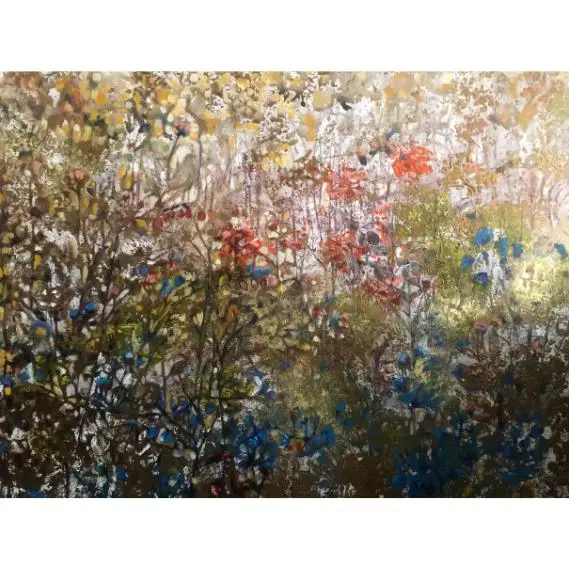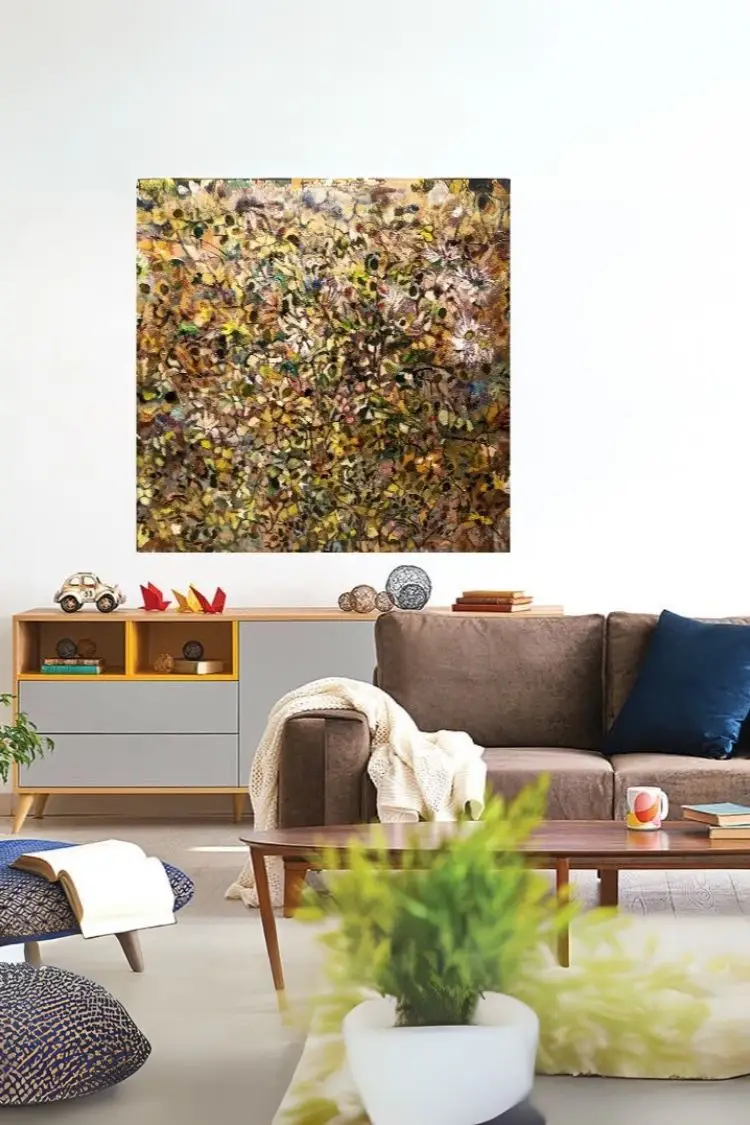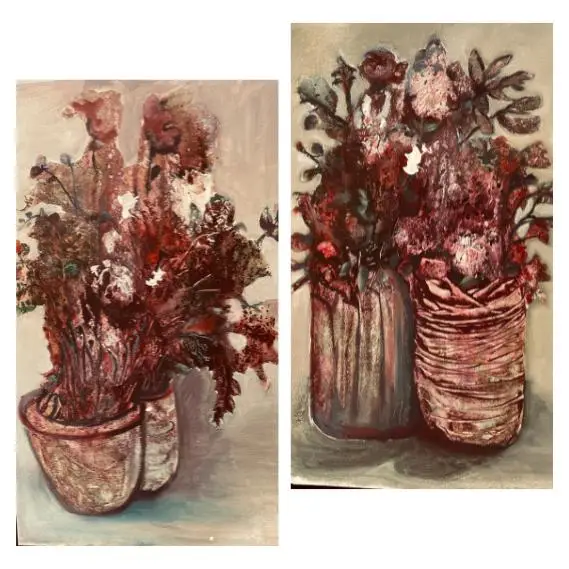
Modern abstract art enhances London homes by complementing architecture, natural light, and mood. It transforms both minimal and heritage spaces through colour, texture, and emotional tone — bridging art, design, and daily life.
Modern abstract art brings colour, energy, and emotion to London homes — turning walls into stories that reflect both space and soul.
There’s something special about how modern abstract art lives within London spaces. The city itself is a collage of contrasts — heritage architecture beside contemporary glass, quiet parks beside the pulse of movement and light. Abstraction fits perfectly into that rhythm.
When I paint, I often think about this balance between old and new — the same balance I see in London homes. Clean lines and neutral tones invite warmth, colour, and emotion. Abstract art fills that space with energy, texture, and calm.
Over the years, I’ve placed my paintings in everything from Georgian townhouses to minimalist lofts. What I’ve learned is simple: a single abstract work can change how a room breathes. It softens hard edges, adds depth to modern simplicity, and brings stillness into busy spaces.
This ongoing dialogue between architecture and art — between structure and expression — is at the heart of how I approach interior pairings.
Anyone who has lived or worked in London knows its light is unpredictable — soft one moment, silver and moody the next. That variability makes it one of the most rewarding environments for abstract art.
The subtle shifts of daylight across textured surfaces bring a painting to life. Warm afternoon tones deepen blues and greens; cool morning light sharpens golds and metallics. Each hour transforms the canvas, reminding us that art is alive — just like the city around it.
That’s why I often guide collectors to consider how light and orientation affect mood. North-facing rooms love warmer hues; south-facing spaces often glow with neutrals and gentle cool tones.
If you’ve read my thoughts on understanding abstract art, you’ll know that light in abstraction is never purely visual — it’s emotional. It sets rhythm, directs focus, and defines the feeling of a space.

The design language of London homes continues to evolve, blending modern minimalism with organic warmth. Below are a few emerging trends that shape how collectors integrate modern abstract art into their living spaces:
London homeowners increasingly value tactile surfaces — velvet sofas, limewashed walls, handmade ceramics. Textured abstract paintings pair beautifully with this aesthetic, adding visual depth and touchable intrigue.
Neutral bases — stone, sand, and off-white — allow art to shine. A large-scale abstract work becomes the anchor, its energy defining the emotional temperature of the room.
Instead of choosing art last, many now begin interior planning around a painting. A single abstract piece sets the tone and palette for the space. I’ve explored this art-first approach in my reflections on decorating with large wall art.
Modern abstract art in period homes creates a compelling dialogue between eras. The clean geometry of abstraction enhances architectural details like crown mouldings and arched windows, bridging past and present through visual rhythm.
If you’re interested in creating emotional balance through colour, I explore this further in my piece on the beauty of colour and emotion.
Each style of London home tells its own story. The key to pairing art effectively lies in harmony and contrast — knowing when to blend and when to surprise.
In period properties — Victorian, Georgian, or Edwardian — abstract art creates an elegant tension. The clean geometry of modern painting highlights ornate cornices, fireplaces, and mouldings. A minimalist composition above a marble mantle feels intentional, not intrusive.
In these settings, I often recommend soft neutral palettes with accents of deep blues or rust tones — colours that respect tradition while speaking of the present.
Modern flats with open layouts and high ceilings invite larger, bolder works. Here, art can define zones: a dynamic abstract near the dining space, a calm tonal piece in the bedroom.
The interplay between light and material becomes essential. Concrete, glass, and metal love warmth — think burnished golds, layered whites, or fluid neutrals.
London’s warehouse conversions often feature exposed brick, beams, and steel. These spaces crave contrast — the softness of paint against structure. I love pairing bold textures or gestural brushwork here, echoing the building’s raw history while adding a new emotional layer.
The emotional language of colour takes on new meaning in the city. After long days surrounded by concrete and pace, colour brings balance.
Cool hues like blue, teal, and silver-grey evoke calm and reflection. Warm undertones — terracotta, ochre, sienna — bring comfort and grounding.
In my reflections on the psychology of abstract art, our nervous system reacts to colour subconsciously. The same principle applies to interiors. Choosing the right palette for your home isn’t just aesthetic — it’s emotional self-care.
A painting’s tone can transform how a space feels throughout the day — bright and energising at sunrise, soothing and introspective at dusk.

Living with art isn’t about filling walls — it’s about building atmosphere.
When a client invites me to recommend or commission a piece, I begin by asking how they want the space to feel. Calm? Vibrant? Reflective? That intention guides everything — size, texture, palette, and rhythm.
Modern abstract art integrates beautifully into London life because it complements the city’s pace. It offers stillness amid movement. The more time you spend with it, the more layers it reveals — just like the city itself.
If you’d like to experience this emotional presence more consciously, read my reflection on mindfulness and art, where I share how slowing down transforms the way we connect with paintings.
Whether you’re collecting or simply decorating, the key is intention and flow.
Start by choosing one emotional centrepiece — a large artwork that defines the tone of your space. From there, pair smaller complementary pieces, sculptures, or textured elements to build rhythm.
When combining figurative and abstract works, balance story and silence. A figurative piece offers narrative focus; an abstract work creates breathing space. I explore this duality further in abstract vs figurative art.
To maintain harmony, echo colours or forms across rooms. Allow negative space between works so each can breathe and command attention.
Above all, trust emotion more than trend. The most timeless interiors are those built on genuine connection — spaces that feel lived in, not styled.
Collectors in London often approach me seeking works that fit seamlessly into their lifestyle — pieces that feel personal yet modern, grounded yet alive.
What I love most about these conversations is their individuality. No two clients ever see colour or form the same way. One might be drawn to layered neutrals for calm; another might crave movement and contrast.
For those beginning their art journey, my guide to investing in abstract art offers practical insight into choosing pieces that carry both emotional depth and lasting value.
Commissioning a work is another way to make that connection deeply personal. My custom painting process begins with a conversation — about space, mood, and intention — so the final artwork feels as though it was born for your home.
What I love about London is how art, architecture, and light are always in conversation. A building designed two centuries ago can hold a painting completed yesterday — the dialogue is timeless.
Modern abstract art doesn’t compete with a space; it enhances it. It reflects the way we live now: fluid, emotional, and open.
When chosen thoughtfully, a painting becomes part of a home’s rhythm — catching morning light, grounding evening calm, and echoing both laughter and quiet alike.
Art has the power to soften a city’s edges—to bring warmth, reflection, and rhythm to modern life.
If you’d like to discover paintings designed to live and breathe within contemporary interiors, you can shop my abstract collection for original works inspired by light, balance, and movement.
Or, if you’d like to discuss a personalised artwork or commission that captures the mood of your home, contact us now to begin the conversation.
Each artwork is a dialogue between colour and architecture—between your world and mine.
Pieces with warmth, texture, and layered depth complement London’s neutral interiors and shifting natural light.
Let it complement in tone but contrast in energy. Art should breathe life into your design, not disappear within it.
Measure your wall space and consider viewing distance. Larger rooms or open layouts benefit from statement pieces, while smaller areas thrive with more intimate works.
Absolutely. London’s natural light transforms art throughout the day. Subtle textures and metallic tones respond beautifully to these shifts, creating a living rhythm within your space.
Yes. I create bespoke pieces through my Custom Painting Process, tailored to your home’s palette, size, and emotional atmosphere.





